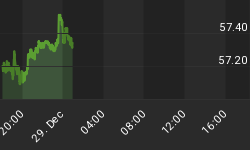Next week, the ECB will hold its monetary policy meeting. The bank was expected to start winding down its stimulus program at the end of 2018. However, Italian turmoil led some analysts to think that the ECB will remain cautious. Will the ECB withstand the pressure? And what does it all mean for the gold market?
Judgment Day for the ECB Is Coming
Yesterday, we stated that the strong May employment report strengthens the Fed’s hand. The hike this month is, however, fully priced in gold. The important question is whether the U.S. central bank will raise interest rates once or twice more this year. We bet that we will see upward moves until the end of 2018, which could put downward pressure on the gold prices (although a lot depends on the messages accompanying the hikes).
However, as the markets have already factored in a U.S. rate hike; the ECB is now the most important player. As a reminder, in March, the ECB has already taken a small step in ending its quantitative easing and dropped a so-called easing bias, i.e., the pledge to increase bond buys if needed (we covered that change in the Gold News Monitor). And the ECB’s asset purchases, at the current monthly pace of €30 billion, are intended to run until the end of September 2018, or beyond, if necessary, and in any case until the Governing Council sees a sustained adjustment in the path of inflation consistent with its inflation aim.
So the judgment day is coming. It may trigger heightened volatility. Be prepared.
To Unwind or Not to Unwind, That Is the Question
Indeed, as Peter Praet, ECB chief economist and a close Draghi’s ally, said yesterday during a speech in Berlin:
Next week, the Governing Council will have to assess whether progress so far has been sufficient to warrant a gradual unwinding of our net purchases.
And what is the likely outcome of that assessment? Well, Praet gave a hint:
Signals showing the convergence of inflation towards our aim have been improving, and both the underlying strength in the euro area economy and the fact that such strength is increasingly affecting wage formation supports our confidence that inflation will reach a level of below, but close to, 2 percent over the medium term. Related: 5 Cool Ways Walmart Is Improving The Shopping Experience
It suggests that the uncertainty caused by a political crisis in Italy will not affect the ECB’s decision. Economics beat politics. The ‘political crisis’ may be actually an exaggeration, at least for Italians, who are used to frequent political changes and interruptions. The ECB is pleased with the rise in inflation, as its annual rate jumped from 1.2 to 1.9 in May (according to Eurostat flash estimate). Hence, investors should prepare for the gradual unwinding of monetary stimulus in the Eurozone. However, they should also remember that ECB’s major policy changes have been taken in two steps in recent years, so Draghi may just lay the groundwork this month for the real change in July.
Implications for Gold
What does it mean for the gold market? Praet’s comments pushed the euro to a two-week high against the dollar, as one can see in the chart below.

(Click to enlarge)
Chart 1: EUR/USD exchange rate over the last month.
The rebound in euro’s strength should be positive for the gold prices. The yellow metal could catch its breath during dollar’s depreciation against the common currency. The biggest political turmoil in Italy is probably behind us. The situation in Spain – when a vote of no-confidence forced out Mariano Rajoy and made Pedro Sánchez a new prime minister – also stabilized, as the next chart – which paints the 10-year Spanish bond yields – shows.

(Click to enlarge)
Chart 2: 10-Year Spain’s Government Yields over the last month.
Therefore, the euro may be not doomed yet. One thing is certain: next week will be hot. Both the Fed and the ECB will hold their monetary policy meetings (actually, the BoJ will also hold a meeting). We will see if they can stand the pressure. Stay tuned!
By Arkadiusz Sieron via Sunshine Profit
More Top Reads From Safehaven.com:

















